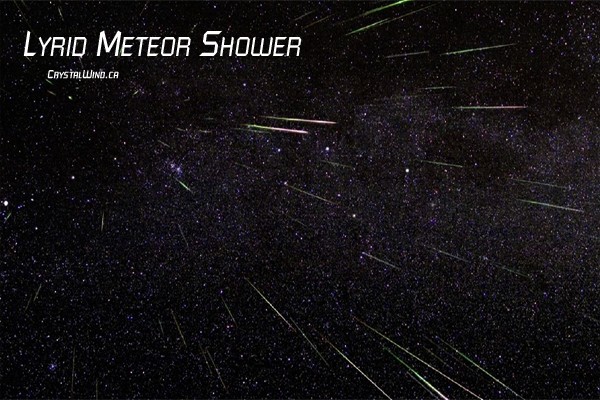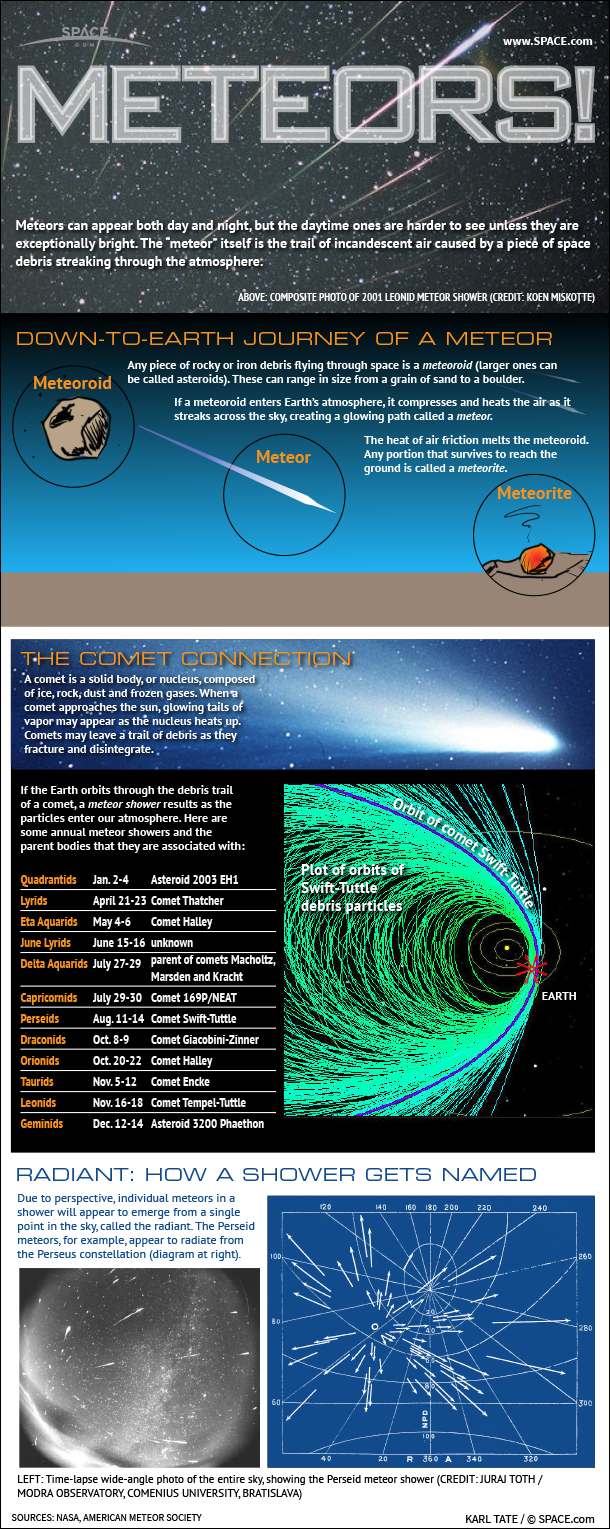Lyrid Meteor Shower - 2023
- Details
- Written by AndEl 0f CrystalWind.ca
- Views: 7282

The yearly meteor drought, which lasts from January to mid-April each year, is invariably broken by the Lyrid meteor shower.
The Lyrid meteor shower is an annual event that occurs between April 15 and April 29, with its peak expected on April 23 at 1:06 UTC in 2023.
The best time to watch the Lyrid meteor shower in 2023 would be late evening on April 21 until dawn on April 22, or late evening on April 22 until dawn on April 23. The shower is known for its narrow peak, which means that there are no weeks-long stretches of meteor-watching as with some other showers.
One of the best things about the Lyrid meteor shower in 2023 is that there will be no moon in the sky during the peak mornings. The new moon falls on April 19, which means that the sky will be dark and ideal for meteor-watching. Under ideal conditions, with a dark sky and no moon, you might be able to see around 10 to 15 Lyrids per hour. However, the Lyrids are also known for uncommon surges that can sometimes bring rates of up to 100 meteors per hour, so it's worth keeping an eye out for any outbursts during the peak period.
It's important to note that the radiant point of the Lyrid meteor shower is far to the north on the sky's dome, which means that the Southern Hemisphere may see fewer Lyrid meteors compared to the Northern Hemisphere. However, it's still possible to see some Lyrid meteors in the Southern Hemisphere, so it's worth trying to catch a glimpse of this annual meteor shower if you can.
The Lyrids are so named because they appear to radiate out from the constellation Lyra.
The Lyrids, which peak during late April, are one of the oldest known meteor showers: Lyrids have been observed for 2,700 years. (The first recorded sighting of a Lyrid meteor shower goes back to 687 BC by the Chinese.)
The Lyrids are known for their fast and bright meteors, though not as fast or as plentiful as the famous Perseids in August, Lyrids can surprise watchers with as many as 100 meteors seen per hour. Sightings of these heavier showers occurred in 1803 (Virginia), 1922 (Greece), 1945 (Japan), and 1982 (U.S.). In general, 10-20 Lyrid meteors can be seen per hour during their peak.
Lyrids frequently leave glowing dust trains behind them as they streak through the Earth's atmosphere. These trains can be observable for several seconds.
Occasionally, the shower intensifies when the planets steer the one-revolution dust trail of the comet into Earth's path, an event that happens about once every 60 years. This results in an April Lyrid meteor outburst. The one-revolution dust trail is dust that has completed one orbit: the stream of dust released in the return of the comet prior to the current 1862 return. This mechanism replaces earlier ideas that the outbursts were due to a cloud of dust moving in a 60-year orbit. In 1982, amateur astronomers counted 90 April Lyrids per hour at the peak and similar rates were seen in 1922. A stronger storm of up to 700 per hour occurred in 1803, and was observed by a journalist in Richmond, Virginia.
Viewing Tips
The Lyrids are best viewed in the Northern Hemisphere during the dark hours (after moonset and before dawn). Find an area well away from city or street lights. Come prepared with a sleeping bag, blanket or lawn chair. Lie flat on your back with your feet facing east and look up, taking in as much of the sky as possible. After about 30 minutes in the dark, your eyes will adapt and you will begin to see meteors. Be patient—the show will last until dawn, so you have plenty of time to catch a glimpse.
Counts typically range from 5 to 20 meteors per hour, averaging around 10. As a result of light pollution, observers in rural areas will see more than observers in a city. Nights without the Moon in the sky will reveal the most meteors. April Lyrid meteors are usually around magnitude +2. However, some meteors can be brighter, known as "Lyrid fireballs", cast shadows for a split second and leave behind smokey debris trails that last minutes.
According to the American Meteor Society, they will peak on the evening of April 21 into the early morning hours of April 22. If you can't get out that night or the weather doesn't cooperate where you are, one night before or after the peak is also expected to present a pretty good viewing opportunity as well.
The Radiant
Their radiant—the point in the sky from which the Lyrids appear to come from—is the constellation Lyra, the harp. Lyrids appear to particularly radiate out from the star Vega—Vega is the brightest star within this constellation. (Helpful Hint: Vega is one of the brightest stars in the night sky and is easy to spot in even light-polluted areas.) The constellation of Lyra is also where we get the name for the shower: Lyrids.
It is actually better to view the Lyrids away from their radiant: They will appear longer and more spectacular from this perspective. If you do look directly at the radiant, you will find that the meteors will be short—this is an effect of perspective called foreshortening.
Note: The constellation for which a meteor shower is named only serves to aid viewers in determining which shower they are viewing on a given night. The constellation is not the source of the meteors.
What causes the Lyrids?
Lyrid meteors are little pieces of Comet Thatcher, a long-period comet that orbits the sun about once every 415 years. Pieces of debris left in the comet's wake, however, make an appearance every year. (Comet Thatcher's most recent perihelion, or closest approach to the sun, was in 1861. It won't be back until the year 2276.)
Meteor showers occur when the Earth crosses the path of a comet, colliding with a trail of comet crumbs. That's why they happen around the same time every year and appear to originate from specific points in the sky. As they burn up in the atmosphere, the meteors leave bright streaks in the sky commonly referred to as "shooting stars." [Infographic: How Meteor Showers Work]

© 2023 crystalwind.ca. All rights reserved. We track all IP addresses with sniffer technology. Using a Proxy/VPN will not hide your IP address. This post first appeared on CrystalWind.ca.
Liked this article? Dive deeper into personal growth and wellness! Check out CrystalWind.ca for spiritual wisdom or explore AromaWorx.ca for natural well-being tips. Spread the positivity—share this with friends on their happiness journey!
Let’s Chat! Drop Your Thoughts Below! ![]()
Latest Articles
Dive into the Mystical World of the Crystal Wind Oracle Deck!
Get All the Enchanting Details Now!
NEW Expanded Boxed Edition!
Now with 58 Cards for Richer Wisdom!

Imagine a world of inspiration and healing, free for all—made possible by YOU!
Donate Now—Ignite the Magic at CrystalWind.ca!

Epilepsy - Finding A Cure
Your donation can make a difference!
Help us find a cure – donate now!
Unlock Your Light: Join Lightworkers Worldwide on CrystalWind.ca!
Articles: The Founders
Articles: Cosmic Neighbours
Articles: Galactic History
Follow Us!
Featured This Month
Crystals for Virgo
As the warmth of summer begins to soften into the crispness of autumn, the Sun... Read more
The Vine: September 2nd - September 29th
The Autumnal Equinox ( Alban Elfed ) Celtic Symbol : The White Swan Read more
Mabon in Modern Times: Fresh Takes on the Au…
The Mabon season begins somewhere around the 21st-22nd of September and cont... Read more
Sun in Virgo
An Overview of Sun Sign Characteristics for Virgo Virgo is guided by Mercur... Read more
Sweet Violet
Sweet Violet Faithfulness and modesty. “I will always be true to you.” Helps... Read more
Mabon Magic: Ideas For Fall Decoration And R…
Welcome (almost!) to Fall! We’re turning the Great Wheel once again, toward ... Read more
Watermelon Tourmaline
Synonym: Rainbow Tourmaline The watermelon tourmaline is a rare variety t... Read more
Peridot: The Healer's Stone
Peridot has been used as a Power Stone for centuries. Peridot fosters emotio... Read more
Virgo Mythology
The Virgo Myth In all of constellation mythology, few legends are as misund... Read more













































